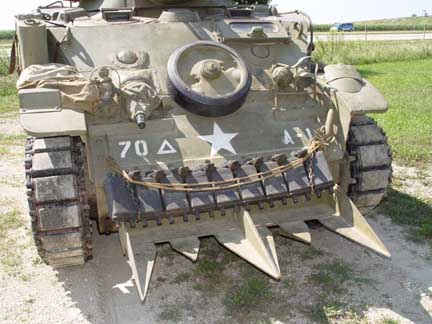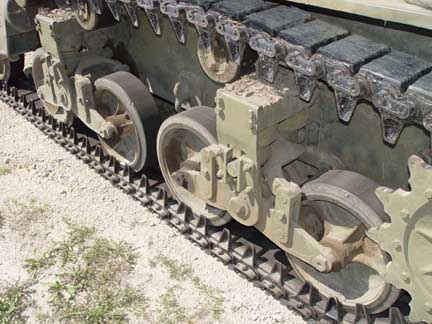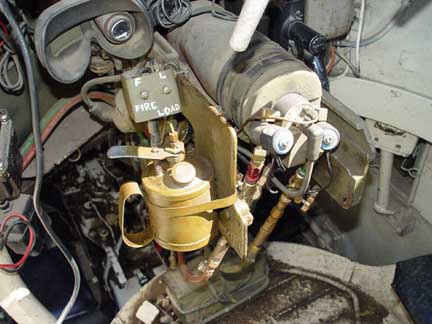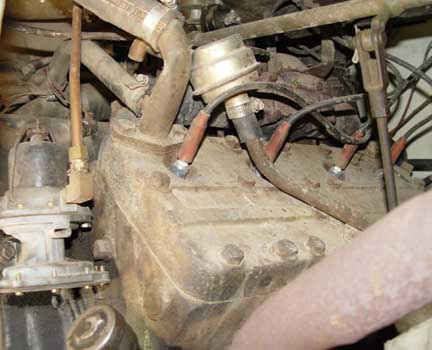
M5A1 LIGHT TANK "STUART"
INTRODUCTION
During the 1930's the United States Army did not consider tanks to be
a relevant weapon on the battlefield. Consequently, little research
and development was performed. German victories in Europe exploiting
firepower and mobility of tank warfare rekindled interest in tanks
among U.S. military leaders, resulting in development plans for a light
tank. Several models of the light tank were developed, including the
M1, M2 and M3 series. In 1942 production began on the M5 series light
tank at the Cadillac Division of General Motors Corporation.
There was no M4 light tank designation in order to avoid confusion with
the M4 medium tank, then under production. In September of 1942
design improvements were made, culminating in the M5A1, the ultimate
refinement of the 1930's vintage U.S. light tank technology.
A total production of 6810 M5A1 tanks occurred from 1942 to 1944.
DESIGN CONCEPT AND DEVELOPMENT
Evaluation of the M5A1 design concept entails the basic principles
of tank warfare; armor, firepower and mobility.
The inherent nature of the light tank implies light armor which is
an obvious deficiency for a combat vehicle. The frontal armor was
rolled homogeneous steel approximately 1.125 inches (29 mm), sufficient
for the Far East theater, but insufficient for German munitions especially
toward the end of the war.
The vehicle had a relatively high profile (height 101 inches),
easing the job of enemy gunners to acquire a target.
Light tank also implies light firepower
which, in the form of a 37mm main gun, was inferior to other combat
vehicles at the time in the European theater. However, the
armament was quite effective against Japanese combat vehicles in the
Far East theater. Mobility was impressive with a maximum speed of 36 MPH.
Interviews with actual drivers indicated that speeds in excess of 45 MPH
were readily achieved. The V8 engines were very quiet and the Hydramatic
transmissions allowed easy gear shifting, resulting in a stealthy vehicle.
ENGINEERING CHARACTERISTICS
The M5A1 was equipped with a .30 caliber bow machine gun,
.30 caliber coaxial machine gun,
37 mm main gun and .50 caliber anti-aircraft machine gun. The M5A1 was originally
equipped with a .30 caliber anti-aircraft machine gun on the turret but
most tankers acquired the .50caliber machine gun since it was more effective.
Ground pressure is 12.3 psi. The suspension uses vertical volute springs.
The controlled differential is on the right side of the driver.
This is essentially a 2 speed automatic shift gear box coupled to 2
drive shafts from 2 automatic 4 speed transmissions. This gives the vehicle 8
speeds forward and 2 speeds in reverse, all automatic shift.
The power plant is the 346 cu.in.
flat head V8 engine, two of which are mounted in the rear of the vehicle,
connected to 4 speed Hydramatic transmissions. Each engine generated 110
horsepower. A two barrel Carter carburetor provides fuel to the engine with
thermal spring automatic chokes for cold starts.
The tank commander/main gun
loader sits on the right, while the gunner sits on the left.
A gyroscope to the right of the turret is used to aid in aiming the
main gun on irregular terrain. The M5A1 had a crew of 4: the driver,
assistant driver/bow gunner, main gunner and tank commander/loader.
The M6 periscope was used in 5 locations on the vehicle with 4 looking
forward and one to the rear.
USAGE IN WORLD WAR II
The M5 made its debut in the invasion of Casablanca in French North Africa.
By 1943, and at the time of the invasion of Sicily, the M5A1 was becoming the
standard light tank of the American armored divisions.
Because of limited firepower, the M5A1 eventually took on reconnaissance and
escort duties in Italy and, after the invasion of Normandy, throughout Europe.
In the Pacific theater, the M5A1 made its debut at Roi-Namur in February of
1944 and on Saipan, the same year. The M5A1 was quite effective against
most Japanese armor, even the
Japanese Type 97 Chi-Ha medium tank typically used in the Pacific theater.
The 37 mm main gun, although obsolete in Europe, was found to be effective
against Japanese targets. Consequently, many other vehicles carrying
the 37 mm gun, such as the M8 armored car and M3 anti-tank gun were
retained and used in the Pacific theater.
ADDITIONAL INFORMATION ON A SPECIFIC VEHICLE
Figure 1 is a view of M5A1 Light Tank, serial number 1243.

Figure 1
This tank was manufactured by Cadillac Motor Car Company in
1942. Cadillac was chosen to build the M5A1 because Cadillac
engines and transmissions were readily available to replace the
Continental radials of the earlier light tank models that were in
short supply. The M5A1 is the most advanced version of the
"Stuart" light tank series used by the U.S., England, Poland,
France, Russia and China in World War II.

Figure 2
Figure 2 is a frontal view of Stuart 1243 with frontal armor
stowage configuration typical of that found in Normandy, 1944.
The Culin (named after Sgt. Culin, the inventor) hedge row cutter
is shown, fabricated from steel obstructions deployed by the
Germans along the French Coast. A length of extra track was
usually secured to the frontal armor for stowage but also acted as
added protection from shape charge anti-tank weapons. A single
road wheel (bogie) is mounted in the center of the glacis plate.
The anti-aircraft machine
gun mounted on the sponson to the right of the turret was
originally .30 caliber, but was typically replaced in the field with
the .50 caliber Browning, which carried more punch.

Figure 3
The vehicle is equipped with a dry pin volute spring suspension
with rubber track blocks and track pins with rubber bushings
(Figure 3). This is the same suspension design for all the Stuart
variants. The four road wheels gave a smooth cross-country ride on
rubber block tracks. The rubber block tracks were light and fast but
did not perform well in ice or snow and were prone to skidding.
Grousers, which enhanced vehicle traction and reduced skidding,
were stored on the turret and installed on the tracks during snowy
conditions.

Figure 4
Figure 4 is a view of the driver's compartment at the left side of
the vehicle. The twin Cadillac engines with automatic
transmissions made for a smooth running machine, which is why
the British often referred to the tank as a "Honey." The automatic
transmission facilitated the training of drivers and the operation of
the vehicle, and is great for reenacting as many present-day folks
have difficulty operating a manual shift. To the right of the
driver's seat is the controlled differential unit, which is essentially
a 2 speed automatic gear box, giving the driver options of up to 8
gears in automatic. Steering levers are mounted above the driver
when stowed and pulled down when the vehicle is being steered.
The driver pulls on the right lever to go right and the left lever to
go left. To stop, both levers are pulled. During turns, vehicle drag
increases and power must be increased to keep the vehicle moving
and help in skidding the turn, which is typical of fully tracked
vehicles of that era.

Figure 5
Figure 5 is a view of the turret fighting compartment showing the
breech end of the 37mm gun. The breech has been removed and a
cannon simulator using propane and oxygen as fuels is placed in
the barrel. An oil reservoir contains diesel fuel that is pumped into
the gun periodically to add smoke and realism to the gun smoke
signature. The tank commander and gunner sit on a turret basket
in this area. A gyroscopic gun stabilization system was provided,
an advanced feature at the time. During reenactments, the gunner
and tank commander sit with open hatches as a safety precaution,
watching out for other reenactors.

Figure 6
Figure 6 is a view of one of the two Cadillac 346 cubic inch flat
head V8 engines as viewed from the rear of the engine
compartment. The engine utilized the General Motors Hydramatic
transmission making shifting easy, along with reduced training
time for new drivers. The engine and transmission were nearly
unaltered from the automotive application, which was usually
found in the Cadillac LaSalle and other top of the line General
Motors civilian vehicles. Since the Ordinance Department had
failed to anticipate tank engine development requirements for
future tank design, civilian automotive engines, especially those in
large supply, were hurriedly adapted for tank usage. The Cadillac
engines operated reliably but were underpowered. With one engine
not functioning, the vehicle had difficulty operating without
disconnecting one of the driveshafts, a time consuming task. The
gasoline fueled V8's ran very quietly unlike the noisy radial
aircraft engines in previous models.

Figure 7
Figure 7 shows Stuart number 1243 in action at the Lowell,
Indiana reenactment in 2001 carrying troops as would typically be
seen in the Normandy breakout of 1944. The Stuart is easily and
economically transportable on tractor trailer units, since it is
neither oversize or over weight. Stuart 1243 can be seen at many
reenactments throughout the Midwest. Information on scheduled
events can be found on this website.
ADDITIONAL TECHNICAL DATA
Weight................33500 lb.
Length.............15 ft.11 in.
Width...............7 ft. 6 in.
Height..............8 ft. 5 in.
Ground Clearance.......16.5 in.
Armament:
1 37 mm Gun, M6; ammunition
A.P.C., M51B1, M51B2; A.P.,
M74; H.E., M63
2 caliber .30 machine gun
1 caliber .50 machine gun
Maximum speed............36 mph
Turning radius...........21 ft.
Maximum grade..............60 %
Copyright 1995 Charles C. Roberts, Jr









 BACK TO ROBERTS ARMORY HOME PAGE
BACK TO ROBERTS ARMORY HOME PAGE